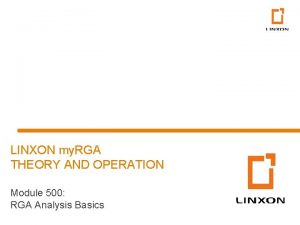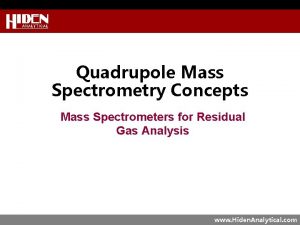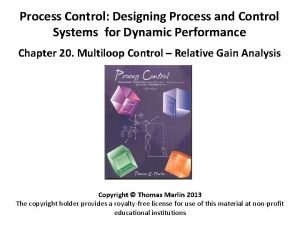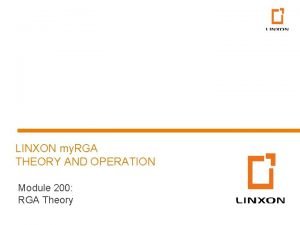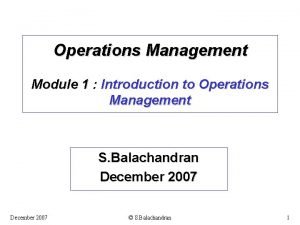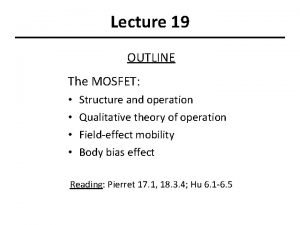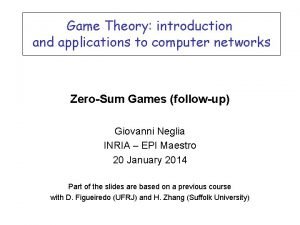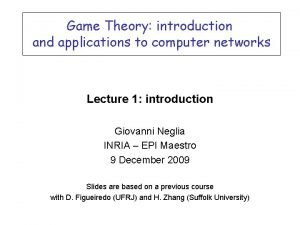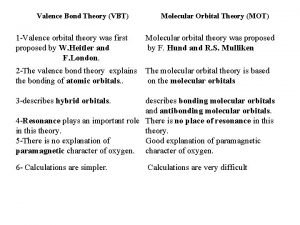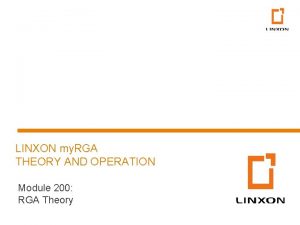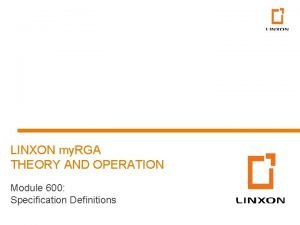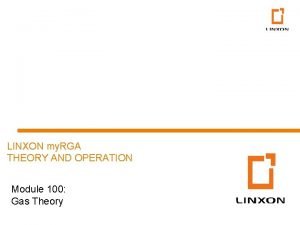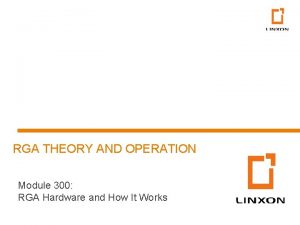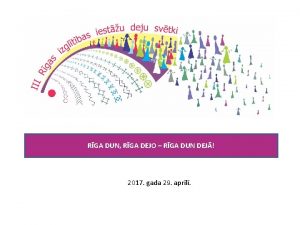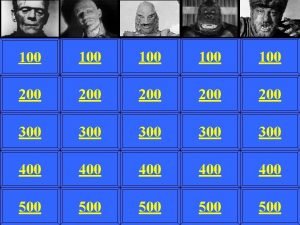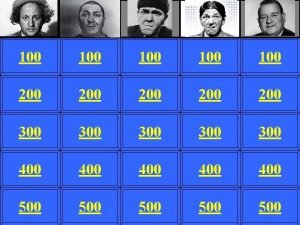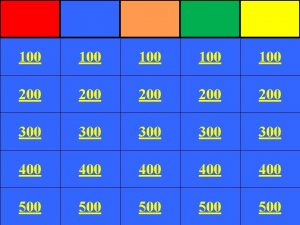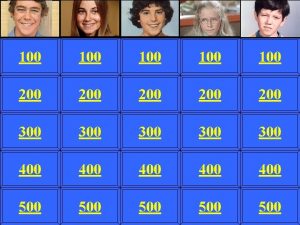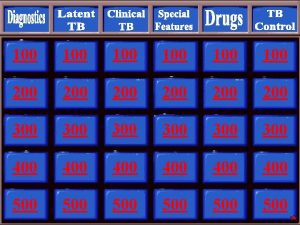LINXON my RGA THEORY AND OPERATION Module 200





























- Slides: 29

LINXON my. RGA THEORY AND OPERATION Module 200: RGA Theory

PURPOSE • Develop expertise with LINXON my. RGA • Understanding RGA theory is an essential part of learning how RGAs work and how they can be used to meet customer needs Module 200: RGA Theory 2

OUTLINE 1 RGA Purpose and Applications Overview 2 Mass-to-Charge Ratio 3 RGA Sensor Overview 4 Mass Spectra Module 200: RGA Theory 3

1 RGA PURPOSE AND APPLICATIONS OVERVIEW Module 200: RGA Theory 4

RGA PURPOSE Determine types and quantities of gases in a system Nitrogen Water Hydrogen Oxygen Module 200: RGA Theory 5

RGA OVERVIEW OF APPLICATIONS • Leak detection • Gas or contaminant identification • Vacuum system diagnostics • Process monitoring and control • Research and development • Manufacturing • Quality assurance • Process efficiency improvement • Scrap reduction / cost reduction Module 200: RGA Theory 6

MASS SPECTROMETRY • Analytical technique used to identify and measure gases • Sampled gas pressure can range from ultra-high vacuum to above atmospheric pressure • LINXON my. RGA can operate at pressure up to 5 x 10 -4 Torr • High sensitivity to detect extremely small gas concentrations or partial pressures Module 200: RGA Theory 7

2 MASS-TO-CHARGE RATIO Module 200: RGA Theory 8

REQUIREMENT TO IONIZE THE GAS • • • RGA needs to: • Filter gas particles according to their mass • Detect and measure the filtered particle stream However, gas particles are neutral • Difficult to filter • Difficult to measure Solution is to ionize the gas • Ions have electric charge • RGA can filter ions by exerting electric forces on them • RGA can measure ion stream by measuring electric current Chapter 2: RGA Theory 9

ION‘S CHARGE NUMBER • An ion is similar to an atom or a molecule, except it has a net charge • Atom or molecule that loses 1 electron • • Singly ionized • Positive ion • Charge number is +1 Atom or molecule that loses 2 electrons • Doubly ionized • Positive ion • Charge number is +2 Chapter 2: RGA Theory Helium ion (He+) z = +1 10

Mass-to-Charge Ratio (m/z) • Essential to a mass spectrometer’s ability to independently measure different gas species • Equal to an ion’s mass (m) divided by its charge number (z) • Basis for filtering ions in an RGA • • Separate, identify and quantify each gas species in a sample Mass-to-charge ratio often shortened to “mass” for convenience • Ion’s charge number often equal to 1 • When z = 1, mass-to-charge ratio = mass Module 200: RGA Theory 11

MEASUREMENT UNITS FOR M/Z MASS-TO-CHARGE RATIO • • amu/e • Clearly shows mass divided by charge • Mass (amu) divided by charge (e) amu 40 amu/e 40 amu • Most common • Mass (amu) divided by charge number No unit of measure (dimensionless) • Integer value with no unit of measure • Mass number divided by charge number 40 Mass-to-charge ratio usually involves integer values • Integer values not affected by choice of measurement unit Module 200: RGA Theory 12

EXAMPLES OF MASS-TO-CHARGE RATIO • Singly ionized helium (He+) • Mass = 4 amu • Charge number = +1 • 4 amu / 1 = 4 amu • Measurement signal at mass 4 indicates helium • Singly ionized argon-40 (40 Ar+) • Mass = 40 amu • Charge number = +1 • 40 amu / 1 = 40 amu • Measurement signal at mass 40 typically indicates argon Module 200: RGA Theory 13

3 RGA SENSOR OVERVIEW Module 200: RGA Theory 14

RGA SENSOR – FUNCTIONAL BLOCKS • Ion source • Mass filter • Detector Ion source Mass filter Detector Module 200: RGA Theory 15

ION SOURCE – IONIZES THE GAS • Gas enters the ion source • Atoms and molecules inside the ion source are ionized • Ions are guided out of the ion source and into the mass filter Gas Ion source Ions Module 200: RGA Theory Mass filter 16

MASS FILTER -FILTERS THE IONS • Mass filter • Filters ions according to their mass-to-charge ratio • Ions with m/z within a specific pass band are passed to the detector • Ions with m/z not within the pass band are rejected Gas Ion source Ions Mass filter Passed ions Detector Rejected ions Module 200: RGA Theory 17

DETECTOR – DETECTS THE IONS • Ion current arrives at the detector • Detector produces output current proportional to the ion current • Output signal represents the gas being measured at that time Electrical current, output signal Gas Ion source Ions Mass filter Passed ions Detector Rejected ions Module 200: RGA Theory 18

4 MASS SPECTRA Module 200: RGA Theory 19

MASS SPECTRUM Graph of current vs. mass-to-charge ratio (“mass”) • Mass scale (horizontal axis) identifies different ions being detected • Current scale (vertical axis) indicates relative amounts 28 amu, N 2+ Nitrogen 18 amu, H 2 O+ Water Current (A) • 2 amu, H 2+ Hydrogen 32 amu, O 2+ Oxygen Mass (amu) Module 200: RGA Theory 20

COMMON PEAKS Gas Primary ion Mass Hydrogen (H 2) H 2+ 2 amu Helium (He) He+ 4 amu Water (H 2 O) H 2 O+ 18 amu Nitrogen (N 2) N 2+ 28 amu Oxygen (O 2) O 2+ 32 amu Argon (Ar) Ar+ 40 amu Module 200: RGA Theory 21

ARGON EXAMPLES, ISOTOPE PEAKS • Argon has isotopes 40 Ar, 38 Ar and 36 Ar • Spectrum can be normalized Ion m/z Normalized Amplitude • Scale highest peak, 40 Ar+, to 100% 40 Ar+ 40 100% 36 Ar+ 36 0. 3% • 38 Ar+ 38 < 0. 1% 36 Ar+ peak height is 0. 3% of the peak height at mass 40 • Allows user to monitor argon at mass 36 to reduce ion current striking detector Module 200: RGA Theory 22

ARGON EXAMPLES, DOUBLY IONIZED PEAKS • Doubly ionized, charge number = 2 • 3 isotopes x 2 ionization states = 6 peaks • Argon peak at m/z 18 can interfere with water peak at m/z 18 • Argon peak at m/z 19 can interfere with fluorine peak at m/z 19 Ion m z m/z Normalized Amplitude 40 Ar+ 40 1 40 100% 40 Ar++ 40 2 20 14. 6% 36 Ar+ 36 1 36 0. 3% 36 Ar++ 36 2 18 < 0. 1% 38 Ar+ 38 1 38 < 0. 1% 38 Ar++ 38 2 19 < 0. 1% Module 200: RGA Theory 23

CRACKING PATTERS – WATER EXAMPLE • Molecules can break into smaller fragments during ionization • For example, water molecules can break into smaller fragments • Typical mass spectrum for water Module 200: RGA Theory 24

WATER SPECTRUM – RELATIVE INTENSITY VS. M/Z H 2 O+ OH+ H+ H 2+ O+ Module 200: RGA Theory 25

SPECTRA LIBRARY • Library of substances and their mass spectra • Peak locations (amu) and normalized relative peak heights (%) Module 200: RGA Theory 26

SPECTRUM GUIDE Possible source gases are shown for each m/z listed Module 200: RGA Theory 27

SUMMARY • Vacuum diagnostics are important for quality and efficiency in both manufacturing and research • LINXON contributes by providing RGAs that measure gases with high sensitivity to detect extremely small partial pressures • Within the RGA, gas is ionized and the measured quantity is the ion current as a function of ion mass-to-charge ratio • Basic analysis of gas composition commonly is performed by examining peaks at masses such as 2, 4, 18, 28, 32 and 40 • For a more precise analysis, one should consider the detailed mass spectrum of each substance present Module 200: RGA Theory 28

THANK YOU! You have completed the RGA Theory module! You may come back and review the content of this module at any time. Module 200: RGA Theory 29
 200 200 300
200 200 300 Asml grade 4 produceren
Asml grade 4 produceren My rga
My rga Rga mass table
Rga mass table Rga
Rga My rga
My rga 200+200+100+100
200+200+100+100 800+200+400
800+200+400 300+300+200+200
300+300+200+200 100 200 300
100 200 300 200+200+300+300
200+200+300+300 100 200 300
100 200 300 Operations management module
Operations management module C device module module 1
C device module module 1 Mosfet theory of operation
Mosfet theory of operation Colinaba
Colinaba Game theory in operation research
Game theory in operation research Game theory in operation research
Game theory in operation research Module 7 erikson's psychosocial theory of development
Module 7 erikson's psychosocial theory of development Trait theory of leadership
Trait theory of leadership Plate tectonics vs continental drift
Plate tectonics vs continental drift Plate tectonics vs continental drift
Plate tectonics vs continental drift Neo classical organizational theory
Neo classical organizational theory Motivation in group formation
Motivation in group formation Semantic satiation
Semantic satiation Rate theory of chromatography
Rate theory of chromatography Lien theory vs title theory
Lien theory vs title theory X and y theory
X and y theory Game theory and graph theory
Game theory and graph theory Site:slidetodoc.com
Site:slidetodoc.com


